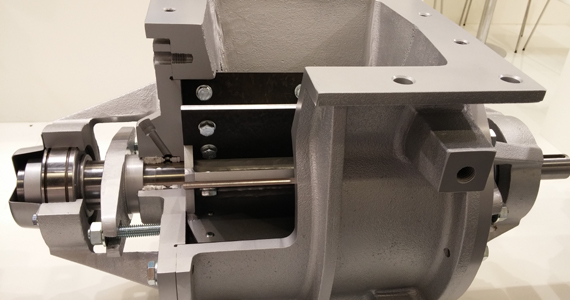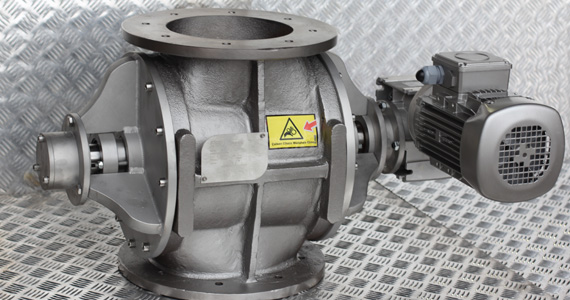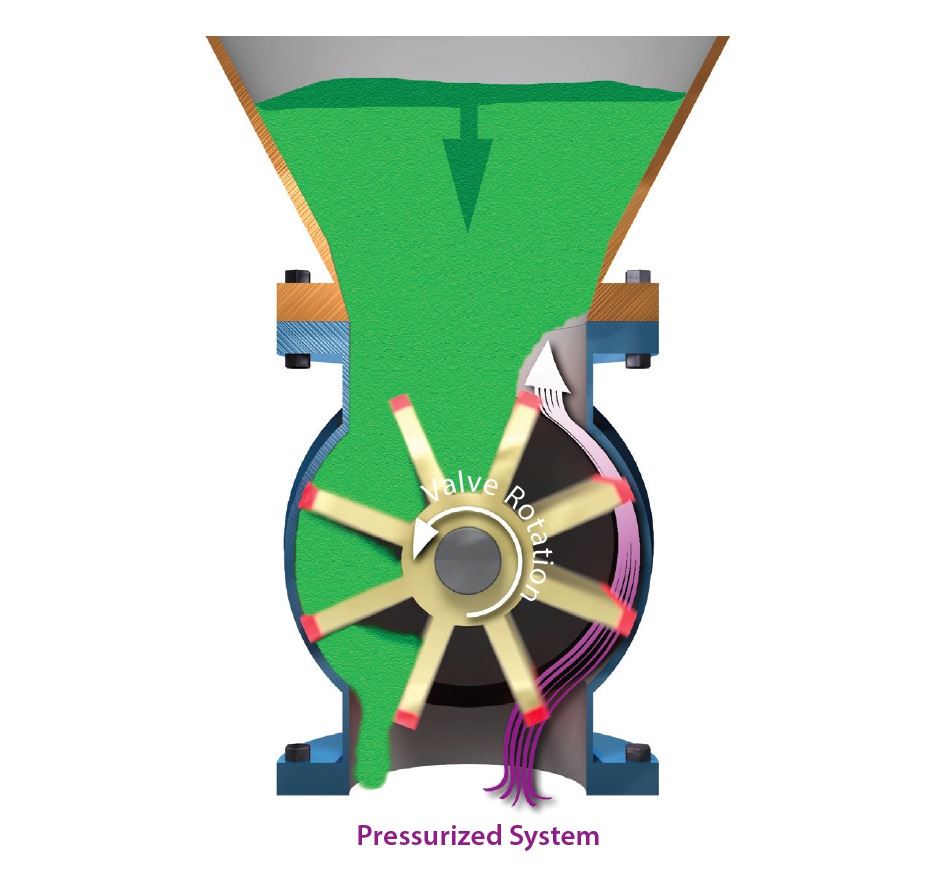How the AIRLOCK Rotary Valve Star Feeder Valve is Used?
Granules conveying with rotary valveThe rotary valve system is suitable for high and low capacity installations. The rotary valve feeds the material into the positive air stream generated by the Multiair blower. After having been carried through the smooth pipe system, the cyclone separates the material from the air stream at the discharge point. These systems can be built quickly using Kongskildes unique standard modular components and can be installed virtually anywhere.
offset type pellet-granul Rotary Valve
The main feature of a Rotary Airlock is to regulate the flow of material from one chamber to another while maintaining a good airlock condition. The material or product being handled is usually dry free flowing powder, dust or granules.
The granule type of product, especially if it is a plaStic type, polythene or nylon etc., does not shear easily and consequently, without considerable care the standard drop-through type of valve leads to valve seizure and also considerable shock loadings.
To minimize these problems the Offset Rotary Airlock ensures lower pocket fillage as its design means that the rotor is Still being filled in the upward cycle with the pellets falling away at the shear point. Similarly, the pelican beak distributes the product across the full width of the rotor.
airlock body. This addition substantially reduces the amount of downtime and the number of man hours required for the cleaning and maintenance of the rotor and airlock internals.

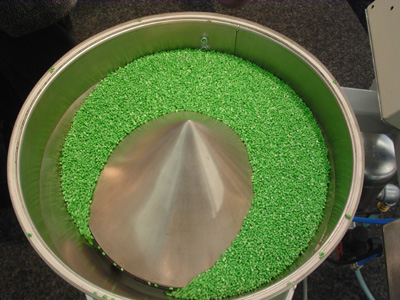
AIRLOCK, ROTARY VALVE - ROTOR TYPES
-





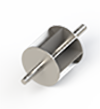

- Rotary Valve - Ailocks-Star Feeder internal Rotors have options such as blade, rounded type, adjusted blade type, stripper and polyamide.
Rotary Valve PDF brochure

Why Choose a DOSERAY Rotary AIRLOCK?
Rotary valves (also called rotary feeders and rotary airlocks)
are devices used to meter, feed, and discharge fine-grained and
powdered bulk or granular materials.
Rotary valves are
installed under silos and also hoppers in order to handle pressure
differentials, i.e., between the silo pressure when receiving the
bulk material and the pressure of downstream conveying equipment
such as tube chain conveyors, screw conveyors, trough chain
conveyors, controlled feed belt weighers, etc.
Rotary valves
are also installed under filters and cyclones in order to be able
to take bulk materials from pneumatic conveying circuits without
causing a large pressure drop in them.
They are also placed
above mixers, driers, and mills in order to volumetrically feed
bulk materials into continuous mixing and processing processes.
And they can also be used in combination with weighing devices in
order to use even more precise gravimetric feeding.
A
rotary valves operation is based on a rotor with a specific
number of rotor vanes. It rotates inside a housing with the same
contour as the vanes, i.e., a housing with an excellent fit
relative to the rotor. Each rotor pocket takes in material from
the inlet opening and discharges it through the outlet, producing
a volumetrically continuous conveyance flow. The delivery rate in
this particular case is defined by the content of the rotor
pockets and the rotors speed. The small clearance between the
housing and the rotor efficiently separates the conveyor systems
flow and counterflow directions with
specific pressure differentials.
A rotary airlock is made
up of:
A housing
A rotor
A bearing
A drive mechanism
An unloading mechanism
Conveying line connections
Rotary valves can be found in a large variety of designs,
materials, and sizes.
Drop-thru rotary valves are the most
commonly used type of rotary valve. They are used as an valve
transition point for the volumetric feeding and discharging of all
kinds of bulk materials.
Self-cleaning rotary valves are
often used when dealing with caking or slightly Sticky bulk
materials. A self-cleaning rotary valve scratches the rotors
pockets empty, ensuring that the
bulk material being handled is
smoothly conveyed.
Side entry rotary valves are usually
used with coarse-grained bulk materials and with granular
materials. The offset inlet, which connects to the rotor diameter
almost tangentially, causes the bulk material to be pushed back by
the scraper, preventing it from becoming jammed between the rotary
valve and the housing. Side entry rotary valves are often used to
convey and meter granular materials in order to prevent damage to
them and ensure that grains are not destroyed.
Blow-through
rotary valves are used to convey bulk materials in pneumatic
conveying systems. The pockets move the product into a conveying
tube, where it is moved by an air stream and blown into the
conveying line.
Much like blow-through rotary valves,
rotary valves with injector valves are used to convey bulk
materials into pneumatic conveying systems. The rotary airlock
meters and conveys the product into an injector valve, where it is
moved by an air stream and blown into the conveying line.
Chemical and pharmaceutical rotary valves are used to discharge
and meter powdery foodstuffs, chemicals, and drugs.
Easy-clean rotary vlaves are used to discharge and meter powdery
foodstuffs, chemicals, and drugs. This type of rotary valve can be
thoroughly cleaned with the help of various extractors.
Knife-equipped rotary valves are used for discharging
refuse-derived fuels such as wood and plaStics. A series of
rotating and stationary knives are responsible for cutting
projecting material and preventing the rotary valve from jamming.
Dust collector rotary valves are used for discharging filter
dust from filters, separators, and cyclone collectors.
Furthermore, explosion isolation for the purpose of preventing
flame propagation in an explosion prevention system can be
implemented with a suitable rotary valves certified for use as a
safety system.
Blow ThrOUGH Rotary Valves
A rotary valve is of no use by itself. Rotary valve, AIRLOCKs are
useful as one component in a bulk or specialty material handling
system. Rotary Valve, AIRLOCK Feeders have wide application in
industry wherever dry free-flowing powders, granules, crystals, or
pellets are used. Typical materials include: cement, sugar,
minerals, grains, plaStics, dust, fly ash, flour, gypsum, lime,
coffee, cereals, pharmaceuticals, etc...
ROTARY VALVE AND PRODUCTS
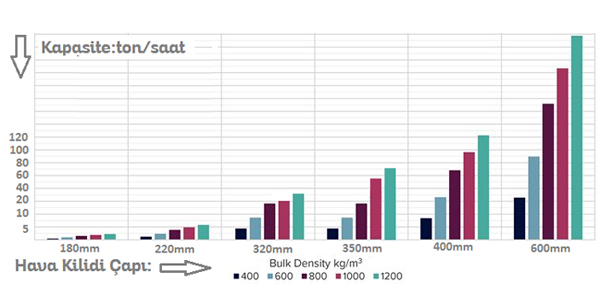
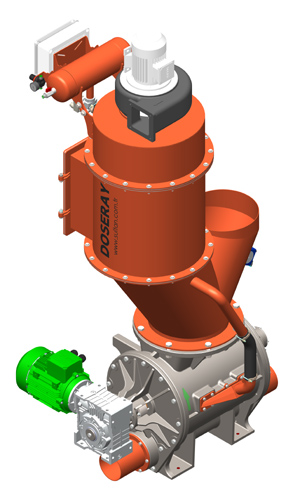
Rotary AIRLOCK ( rotary valve) feeders have wide application in industry wherever dry free-flowing powders, granules, crystals, or pellets are used. Typical materials include: cement, ore, sugar, minerals, grains, plaStics, dust, fly ash, flour, gypsum, lime, coffee, cereals, pharmaceuticals, spray dryer, etc...
- Lebels: rotary valve, rotary AIRLOCK, AIRLOCK valve, rotary feeder, blow through rotary valve, flow through AIRLOCK, silo discharge, cyclone discharge, dust collection, pneumatic conveying, rotary AIR LOCK valve, rotary valve producer , rotary valve price, rotary valve draw
